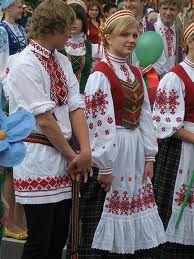Belarus: Belarus People Profile 2012
2012/02/22
Belarus People Profile 2012
 Ethnic Belarusians constitute 81.2% of Belarus's total population. The next largest ethnic groups are Russians (11.4%), Poles (3.9%), and Ukrainians (2.4%). Belarus's two official languages are Russian and Belarusian;Russian is the main language, used by 72% of the population, while Belarusian, the second official language, is only used by 11.9%. Minorities also speak Polish, Ukrainian and Eastern Yiddish.
Ethnic Belarusians constitute 81.2% of Belarus's total population. The next largest ethnic groups are Russians (11.4%), Poles (3.9%), and Ukrainians (2.4%). Belarus's two official languages are Russian and Belarusian;Russian is the main language, used by 72% of the population, while Belarusian, the second official language, is only used by 11.9%. Minorities also speak Polish, Ukrainian and Eastern Yiddish.
Belarus has a population density of about 50 people per square kilometer (127 per sq mi); 71.7% of its total population is concentrated in urban areas. Minsk, the nation's capital and largest city, is home to 1,741,400 of Belarus's 9,724,700 residents. Gomel, with 481,000 people, is the second largest city and serves as the capital of the Homel Voblast. Other large cities are Mogilev (365,100), Vitebsk (342,400), Hrodna (314,800) and Brest (298,300).
Like many other European countries, Belarus has a negative population growth rate and a negative natural growth rate. In 2007, Belarus's population declined by 0.41% and its fertility rate was 1.22, well below the replacement rate. Its net migration rate is +0.38 per 1,000, indicating that Belarus experiences slightly more immigration than emigration.[2] As of 2007, 69.7% of Belarus's population is aged 14 to 64; 16% is under 14, and 14.6% is 65 or older.Its population is also aging: while the current median age is 37,[ it is estimated that Belarusians' median age group will be between 55 and 65 in 2050.[143] There are about 0.88 males per female in Belarus. The average life expectancy is 68.7 years (63.0 years for males and 74.9 years for females).[2] Over 99% of Belarusians are literate.
Belarusians 81.2%, Russians 11.4%, Poles 3.9%, Ukrainians 2.4%, Jews 0.3%, Armenians 0.1%, Lipka Tatars 0.1%, Ruska Roma 0.1%, Lithuanians 0.1%, Azeris 0.1%, others 0.3% (1999 census)
Belarus has historically leaned to different religions, mostly Orthodox, Catholicism (mostly in western regions), different denominations of Protestantism (especially during the time of union with Protestant Sweden).[145] Sizable minorities practice Judaism and other religions. Many Belarusians converted to the Russian Orthodox Church after Belarus was annexed by Russia after the partitions of the Polish-Lithuanian Commonwealth. As a consequence, the Russian Orthodox church now has more members than other denominations.
Belarus's Roman Catholic minority, which makes up about 10% of the country's population[94] and is concentrated in the western part of the country, especially around Hrodna, is made up of a mixture of Belarusians and the country's Polish and Lithuanian minorities. About 1% belong to the Belarusian Greek Catholic Church.
Religion
Belarus was a major center of the European Jewish population, with 10% being Jewish, but the population of Jews has been reduced by war, starvation, the Holocaust, and emigration so that today it is a very small minority of about 1% or less. The Lipka Tatars numbering over 15,000 are Muslims. According to Article 16 of the Constitution, Belarus has no official religion. While the freedom of worship is granted in the same article, religious organizations that are deemed harmful to the government or social order of the country can be prohibited.
- Belarus News
-
- ALBANIA: Europe in 2016: Terror fears, migration, politics. But economy may turn a corner
- AFGHANISTAN: Global growth will be disappointing in 2016: IMF's Lagarde
- AFGHANISTAN: The newly created Eurasian Economic Union (EEU) has shortly got the momentum
- BELARUS: Fundamentally, not much has changed inside Belarus over the last decade
- BELARUS: Belarus Finally Reforms Its Economy?
- BELARUS: Minsk as a Preferred Transit Hub
- Trending Articles
-
- FRANCE: Cavendish doing it for Africa
- CONGO BRAZZAVILLE: Congo: Total abandons oil field citing decrease in global oil prices
- SOUTH AFRICA: South Africa’s Biggest Labor Group to Balance Pay With Job Security
- EUROPEAN UNION: EU meets without Britain for first time since Brexit vote
- NIGERIA: Lagos hosts 2016 Africa fashion week Nigeria
- KENYA: Nairobi to host 14th UN conference on trade and development







